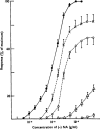Role of the alpha-adrenoceptor in regulating noradrenaline overflow by nerve stimulation. 1971
- PMID: 9142415
- PMCID: PMC3224312
- DOI: 10.1111/j.1476-5381.1997.tb06817.x
Role of the alpha-adrenoceptor in regulating noradrenaline overflow by nerve stimulation. 1971
Abstract
A study of the actions of phenoxybenzamine on transmitter overflow, neuronal and extraneuronal uptake of noradrenaline and in causing α-adrenoceptor blockade was carried out using the isolated cat nictitating membrane preparation.
Phenoxybenzamine increased transmitter overflow elicited by nerve-stimulation at 10 Hz in a concentration dependent manner in the range 10−8 to 10−5 g/ml.
Neuronal uptake of [3H]-noradrenaline was not inhibited by concentrations lower than 10−6 g/ml of phenoxybenzamine. With 10−7 g/ml of phenoxybenzamine a significant increase in transmitter overflow was obtained, although neuronal uptake of noradrenaline was not affected. Higher concentrations of phenoxybenzamine (10−6 and 10−5 g/ml) inhibited the neuronal uptake of noradrenaline and further increased transmitter overflow.
Extraneuronal uptake of [3H]-noradrenaline was inhibited only with the highest concentration of phenoxybenzamine tested (10−5 g/ml) and therefore appears to be unrelated to the effects on transmitter overflow.
There was a significant correlation between the degree of α-adrenoceptor block produced by phenoxybenzamine and the increase in transmitter overflow obtained by nerve stimulation.
These results indicate that phenoxybenzamine, in addition to increasing overflow by preventing reuptake of noradrenaline, may increase transmitter release.
The possibility that phenoxybenzamine acts on α-adrenoceptors in the adrenergic nerve terminal is discussed. These receptors would be involved in a negative feedback mechanism regulating transmitter release.
Figures








Similar articles
-
Role of the -adrenoceptor in regulating noradrenaline overflow by nerve stimulation.Br J Pharmacol. 1972 Apr;44(4):672-88. doi: 10.1111/j.1476-5381.1972.tb07306.x. Br J Pharmacol. 1972. PMID: 4339385 Free PMC article.
-
Influence of reserpine-induced depletion of noradrenaline on the negative feed-back mechanism for transmitter release during nerve stimulation.Br J Pharmacol. 1973 Oct;49(2):214-25. doi: 10.1111/j.1476-5381.1973.tb08367.x. Br J Pharmacol. 1973. PMID: 4367125 Free PMC article.
-
Alpha-adrenoceptor activation of nictitating membrane and iris in cats.Naunyn Schmiedebergs Arch Pharmacol. 1988 May;337(5):519-24. doi: 10.1007/BF00182725. Naunyn Schmiedebergs Arch Pharmacol. 1988. PMID: 2901045
-
Alpha 2-adrenoceptor agonists potentiate responses mediated by alpha 1-adrenoceptors in the cat nictitating membrane.Br J Pharmacol. 1984 Oct;83(2):463-9. doi: 10.1111/j.1476-5381.1984.tb16508.x. Br J Pharmacol. 1984. PMID: 6148985 Free PMC article.
-
Structure-activity relationships in the adrenergic-blocking agents.J Pharm Sci. 1969 May;58(5):511-38. doi: 10.1002/jps.2600580502. J Pharm Sci. 1969. PMID: 4389589 Review. No abstract available.
Cited by
-
Alterations in perivascular innervation function in mesenteric arteries from offspring of diabetic rats.Br J Pharmacol. 2015 Oct;172(19):4699-713. doi: 10.1111/bph.13244. Epub 2015 Aug 14. Br J Pharmacol. 2015. PMID: 26177571 Free PMC article.
-
South American special issue: Editorial.Pharmacol Res Perspect. 2021 Oct;9(5):e00868. doi: 10.1002/prp2.868. Pharmacol Res Perspect. 2021. PMID: 34609071 Free PMC article. No abstract available.
References
-
- Adler E, Rubio MC, Langer SZ. Caminos metabólicos selectivos de la noradrenalina tritiada liberada por estímulo nervioso y por agentes farmacológicos en aurículas aisladas de cobayo. Resúmenes de Comunicaciones de la III Reunión de la Sociedad Argentina de Farmacología Experimental. 1970:10–11.
-
- Boullin DJ, Costa E, Brodie BB. Evidence that blockade of adrenergic receptors causes overflow of norepinephrine in cat's colon after nerve stimulation. J. Pharmac. exp. Ther. 1967;157:125–134. - PubMed
Publication types
MeSH terms
Substances
Personal name as subject
- Actions
- Actions
- Actions
- Actions
LinkOut - more resources
Full Text Sources
Miscellaneous

